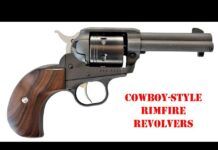We live in a polymer-frame, striker-fire, double-stack world. At first glance, most of these types of pistols seem to offer the same features, so what separates these pistols aside from price point and manufacturer? A lot, we found out. We chose three recently introduced 9mm models for testing. The first was the Ruger American Pro Duty, which is Ruger’s new full-size striker-fire pistol with a modular grip. The second was the next evolution of the Springfield Armory XD series, the XD MOD.2 4-Inch Service, which wears SA’s GripZone texture in the grip. We previously tested the compact XD MOD.2 3.3-inch models in both 9mm and 45 ACP and gave them an A rating. The third 9mm striker fire was the new M&P9 M2.0 from Smith & Wesson. We tested S&W’s first generation of M&P9 models and found they rated from A to B+, depending on the model. All three pistols are striker-firers, use a polymer receiver/frame, are chambered in 9mm, have double-stack magazines, and are full-size pistols.
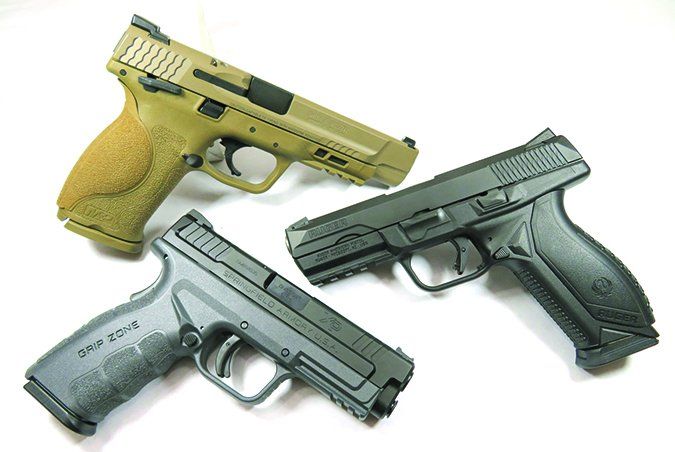
Range Data
| Hornady American Gunner 9mm Luger 115-gr. XTP | Ruger American Pro Duty | S&W M&P9 M2.0 | Springfield Armory XD MOD.2 Service |
| Average velocity | 1077 fps | 1100 fps | 1095 fps |
| Muzzle energy | 296 ft.-lbs. | 309 ft.-lbs. | 306 ft.-lbs. |
| Smallest group | 1.9 in. | 1.2 in. | 1.3 in. |
| Average group | 2.2 in. | 1.5 in. | 1.5 in. |
| SIG Sauer 9mm Luger 115-gr. FMJ | |||
| Average velocity | 1095 fps | 1105 fps | 1110 fps |
| Muzzle energy | 306 ft.-lbs. | 312 ft.-lbs. | 315 ft.-lbs. |
| Smallest group | 1.7 in. | 1.4 in. | 2 in. |
| Average group | 1.9 in. | 2.1 in. | 2 in. |
| Aguila 9mm Luger 124-gr. FMJ | |||
| Average velocity | 1046 fps | 1067 fps | 1077 fps |
| Muzzle energy | 301 ft.-lbs. | 314 ft.-lbs. | 319 ft.-lbs. |
| Smallest group | 2.7 in. | 1.2 in. | 2.1 in. |
| Average group | 3 in. | 1.8 in. | 2.2 in. |
| Liberty Ammunition Civil Defense 9mm Luger 50-gr. HP | |||
| Average velocity | 2075 fps | 2094 fps | 2095 fps |
| Muzzle energy | 478 ft.-lbs. | 487 ft.-lbs. | 487 ft.-lbs. |
| Smallest group | 1.8 in. | 1.5 in. | 1.7 in. |
| Average group | 2 in. | 2 in. | 2 in. |
| To collect accuracy data, we fired five-shot groups from a bench using a rest. Distance: 25 yards with open sights. We recorded velocities using a ProChrono digital chronograph 15 feet from the muzzle. | |||
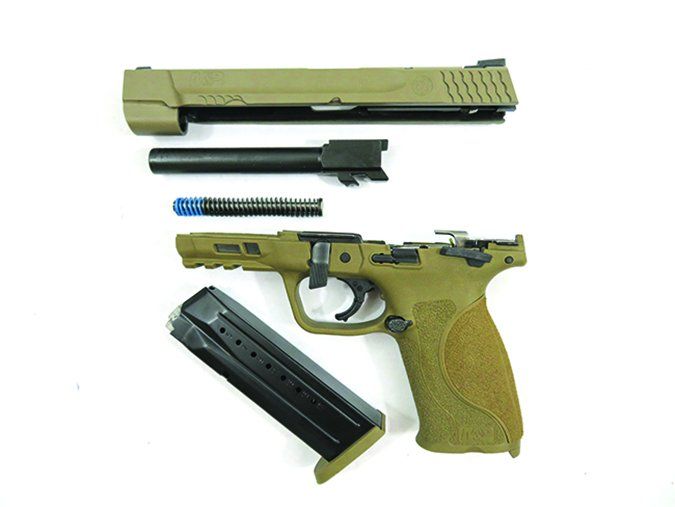
For range testing, we used a combination of hollow-point and full-metal-jacket bullets in different bullet weights. Our four test loads consisted of Hornady American Gunner, loaded with a 115-grain XTP bullet, a SIG Sauer 115-grain full-metal-jacket (FMJ) bullet, Liberty Ammunition Civil Defense’s 50-grain hollow-point bullet, and Aguila’s 124-grain FMJ load. We tested accuracy at 25 yards using a rest, then moved the target to 15 yards for speed shooting and reload manipulations. We were paying close attention to accuracy, ease of use, reliability and consistency. As the brass cooled, here’s what we learned.
Smith & Wesson M&P9 M2.0 11537 9mm Luger, $599
GUN TESTS GRADE: A
The M&P9 M2.0 is a refined striker-fire pistol with a crisp trigger, excellent grips inserts, and good accuracy.
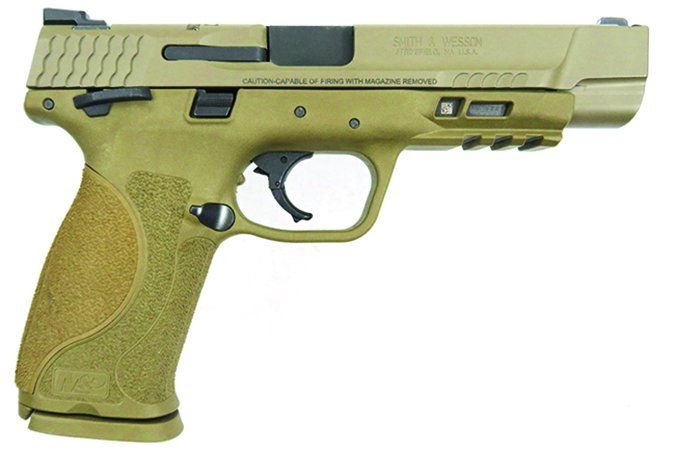
| ACTION TYPE | Striker fire, locked breech, tilting barrel |
| OVERALL LENGTH | 8.25 in. |
| OVERALL HEIGHT | 5.4 in. |
| MAX WIDTH | 1.5 in. |
| WEIGHT UNLOADED | 26.9 oz. |
| WEIGHT LOADED | 33.7 oz. |
| SLIDE MATERIAL | Stainless steel |
| SLIDE-RETRACTION EFFORT | 19 lbs. |
| RECEIVER MATERIAL | Polymer |
| FINISH | FDE |
| FRONT STRAP HEIGHT | 2.2 in. |
| REAR STRAP HEIGHT | 3.2 in. |
| BARREL LENGTH | 5 in. |
| PISTOL GRIP | Textured polymer, modular |
| GRIP THICKNESS (max) | 1.4 in. (large insert) |
| GRIP CIRCUMFERENCE (max) | 6 in. (large insert) |
| MAGAZINE | (2) 17-rd. steel |
| REAR SIGHT | Steel, fixed, white two dot |
| FRONT SIGHT | Steel, fixed blade, white dot |
| SIGHT RADIUS | 7.25 in. |
| TRIGGER PULL WEIGHT | 5.43 lbs. |
| TRIGGER SPAN | 2.8 in. |
| SAFETY | 2-pos. lever |
| WARRANTY | 1 year |
| TELEPHONE | (800) 331-0852 |
| WEBSITE | Smith-Wesson.com |
| MADE IN | USA |
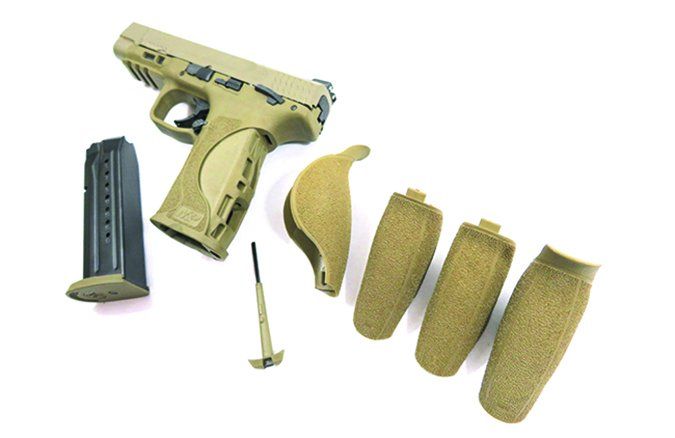
Our test sample came in a hard case with two stainless-steel magazines. It featured a 5-inch stainless-steel barrel. The finish was a nicely executed Cerakote FDE. The M&P9 M2.0 still features an 18-degree grip angle of the first-generation M&P, which is similar to a 1911’s. Most testers agreed this grip angle was comfortable to shoot. The high grip means the bore axis is closer to your hand, which translates into the pistol being more comfortable to shoot with faster aim recovery, because the muzzle flips less in your grip. The receiver front has a Picatinny-style rail to attach accessories.
The controls, namely the slide release and magazine release, are the same as on the M1.0 except with M2.0 they are ambidextrous. The magazine-release button is made of steel and sized so fast manipulations were easier to perform. The M2.0 comes with an ambidextrous thumb safety, which some testers felt was redundant to the other safety features like the trigger and drop safety. We agreed the thumb safety is a good feature.
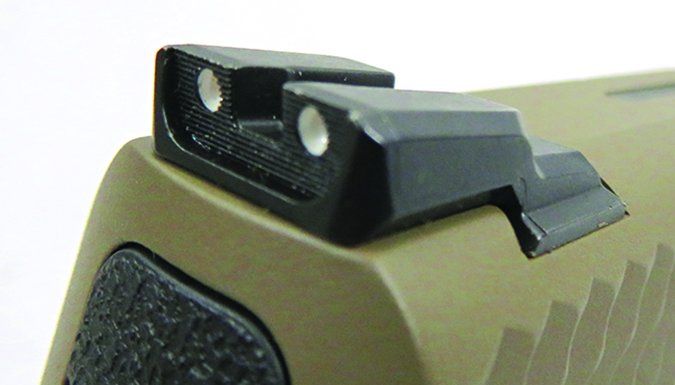
The aggressively textured grips, which were similar to a medium-grit sandpaper offered good adhesion but without abrasion. This texture is used on all four grip inserts as well. They were sized small, medium, medium-large, and large. Two inserts have a beavertail and two do not. All have a palm swell, which we thought provided good contact with the palm of the shooting hand. The palm swell cuts down on gaps that pistols with flat-grip sides may cause. We thought the grip-module design was well thought out. To attach an insert, the owner twists the frame tool and removes the insert from the butt of the pistol by sliding the insert off. We thought this process was simple, did not allow dirt to get under the insert, and was very solid.
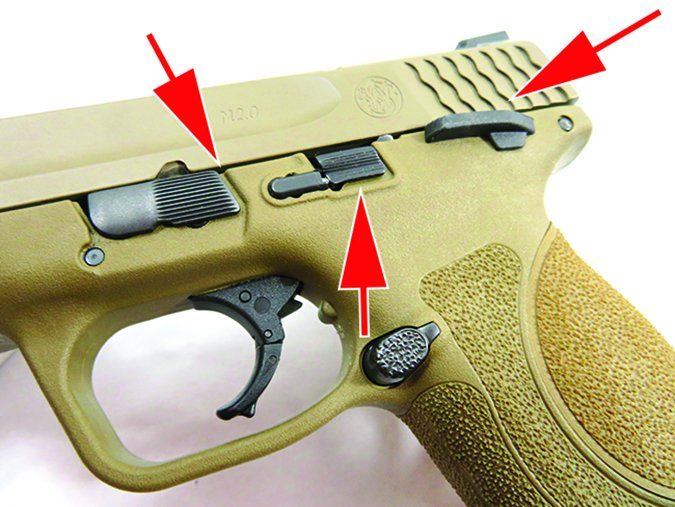
The front grip strap is straight and textured without finger grooves. We liked these grips better than the Ruger’s. The grips on the S&W also seemed better integrated into the frame than the Ruger’s. The stainless-steel slide was profiled a bit different than M1.0 models, with metal relieved to make it lighter and show more taper at the muzzle for ease in holstering. A tactile and visible loaded-chamber indicator is built into the top of the slide. The steel sights are dovetailed into the slide and offer as much sight radius as possible. The rear has two white dots, and the front has a single dot. Connect the dots to aim. The sights are low profile and snag free. We like these sights, though the front sight on the SA was the easiest to pick up since it was fiber optic.
This new M&P9 uses an extended stainless-steel chassis embedded in the polymer receiver. According to S&W, the chassis makes the pistol more rigid, reducing flex and torque when firing. We did not have an older M&P on hand to test side by side, but we did agree the M2.0 had less felt recoil than the Ruger and Springfield.
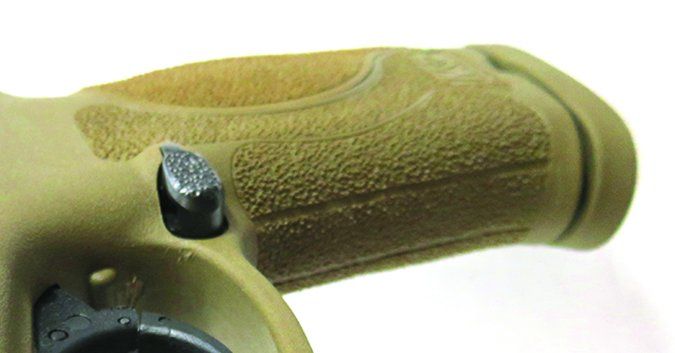
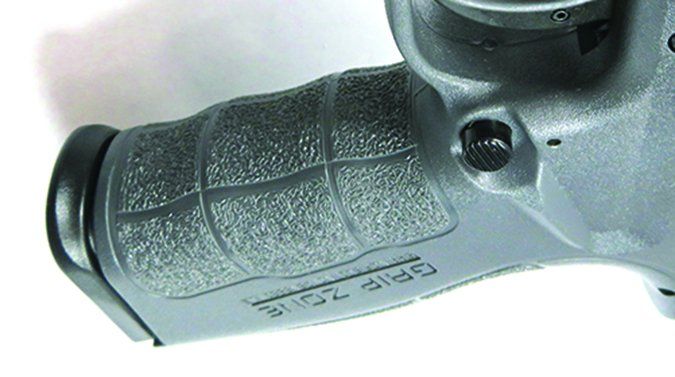
The trigger was crisper and had a tactile and audible reset compared to older M&P pistol triggers. It is the same trigger used in Performance Series M&P pistols. This trigger really separated the M&P M2.0 from all the other striker-fired polymer-frame pistols we’ve tested. In this case, the team was divided on which trigger was the best and decided it was a tie between the S&W and Springfield guns. They both have great triggers. The trigger on the S&W is wide, and we felt we had more control with it compared to triggers with a safety lever built into the trigger face like those found on the Ruger and Springfield Armory handguns. It also felt more consistent. There is a trigger stop molded into the frame, high up behind the trigger, which could be a potential issue if debris gets behind the trigger.
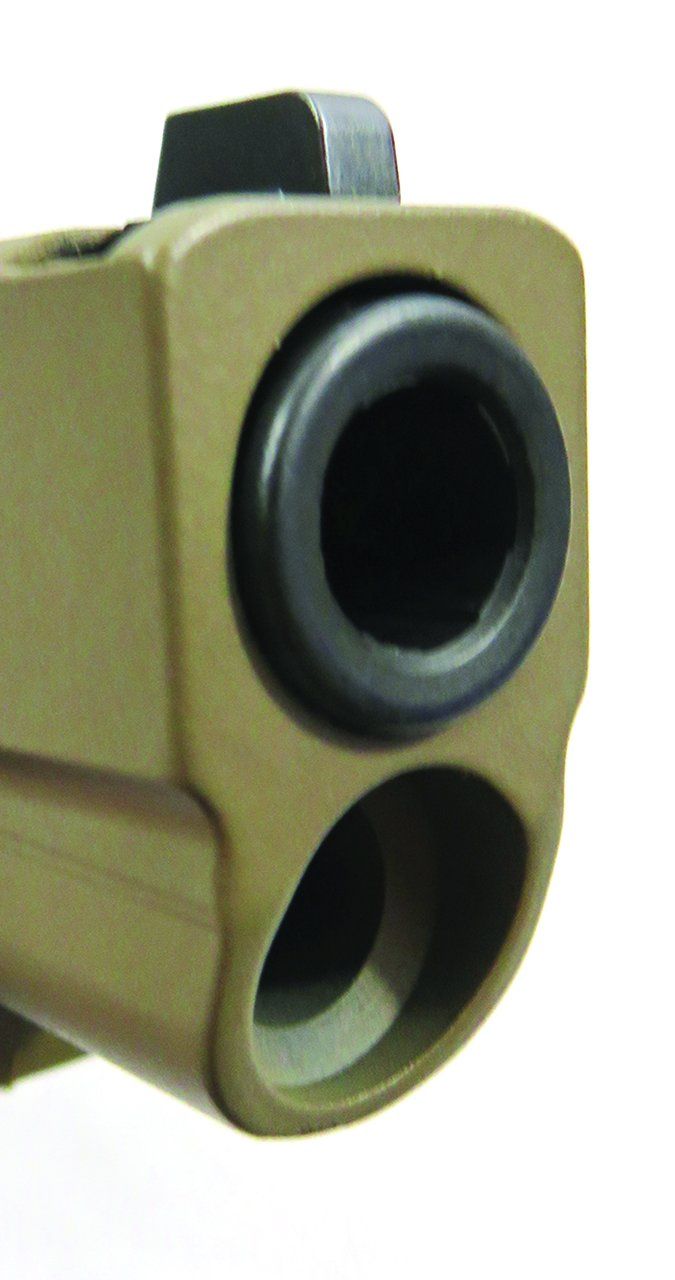
The M2.0 also field strips the same way as do older models. Remove the magazine, lock back the slide, and rotate the takedown lever. The slide assembly can then be removed from the receiver. Old M&P magazines are compatible with the new M2.0.
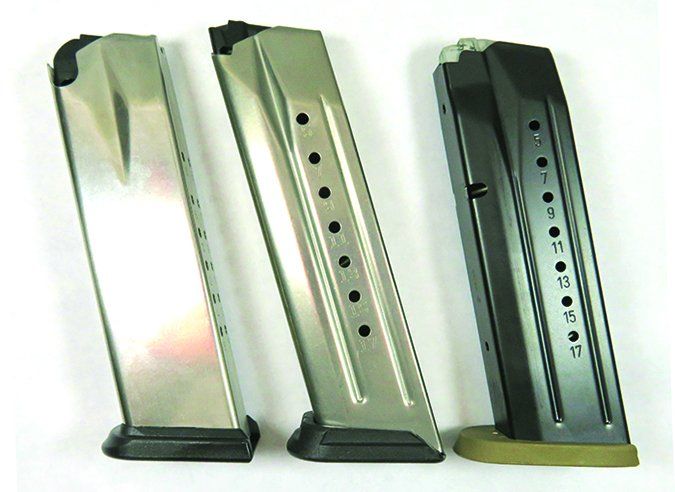
The M2.0 operated flawlessly with all the test ammo. With Hornady American Gunner, one tester was able to shoot a 1.2-inch five-shot group at 25 yards. The Aguila, SIG, and Liberty best groups averaged 1.2 to 1.5 inches. Average groups for all were mostly under 2 inches at 25 yards. For speed assessments, we fired a Bill Drill, shooting six shots as quickly as possible, while ensuring all six shots hit the target. This drill is helpful because it teaches sight tracking, recoil management, and trigger manipulation. The excellent sights and enhanced trigger allowed our test team shooters to get on targets fast and accurately.
Our Team Said: The trigger and sights allow a user to shoot this pistol well. It was the most expensive pistol in the test, but only by $30. We also like the four options in grip inserts and the texture. We liked this pistol a lot and would buy it as a full-size carry pistol or a home-defense firearm.
Ruger American Pro Duty 8605 9mm Luger, $579
GUN TESTS GRADE: B+
The American is quite capable and ran well with good accuracy. The grip inserts gave us a bit of trouble initially. Sights were excellent and the recoil mild.
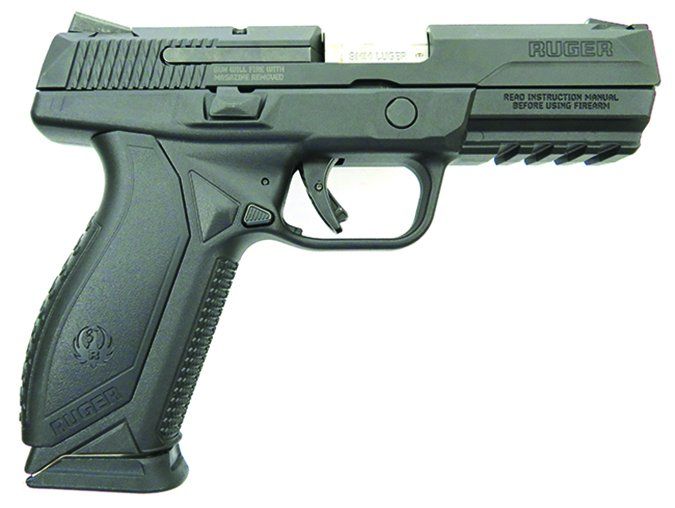
| ACTION TYPE | Striker fire |
| OVERALL LENGTH | 7.5 in. |
| OVERALL HEIGHT | 5.6 in. |
| MAX WIDTH | 1.4 in. |
| WEIGHT UNLOADED | 30.5 oz. |
| WEIGHT LOADED | 37.3 oz. |
| SLIDE MATERIAL | Stainless steel |
| SLIDE-RETRACTION EFFORT | 17 lbs. |
| RECEIVER MATERIAL | Polymer |
| FINISH | Black |
| FRONT STRAP HEIGHT | 2.5 in. |
| REAR STRAP HEIGHT | 3.9 in. |
| BARREL LENGTH | 4.17 in. |
| PISTOL GRIP | Textured polymer, modular |
| GRIP THICKNESS (max) | 3.2 in. (large insert) |
| GRIP CIRCUMFERENCE (max) | 6 in. (large insert) |
| MAGAZINE | (2) 17-rd. stainless steel |
| REAR SIGHT | Steel, fixed, Novak white two dot |
| FRONT SIGHT | Steel, fixed blade, Novak white dot |
| SIGHT RADIUS | 6.3 in. |
| TRIGGER PULL WEIGHT | 5.4 lbs. |
| TRIGGER SPAN | 2.8 in. (large insert) |
| SAFETY | None |
| WARRANTY | N/A |
| TELEPHONE | (770) 432-1202 |
| WEBSITE | Ruger.com |
| MADE IN | USA |
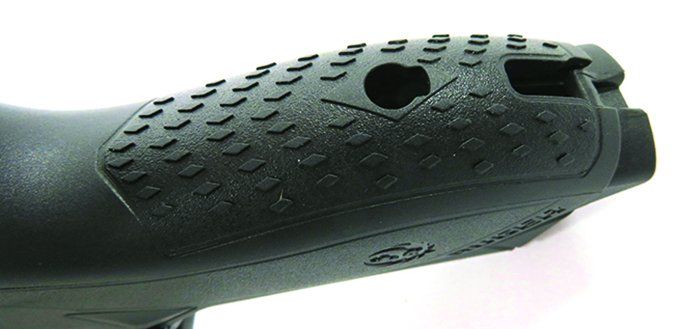
The American comes in a hard case with two stainless-steel magazines and three grip inserts. We suspect that Ruger might have been vying for the U.S. Army’s Modular Handgun System (MHS) program (that recently chose the SIG P320) because many of the pistol’s specs sync up with the Army’s requirements.
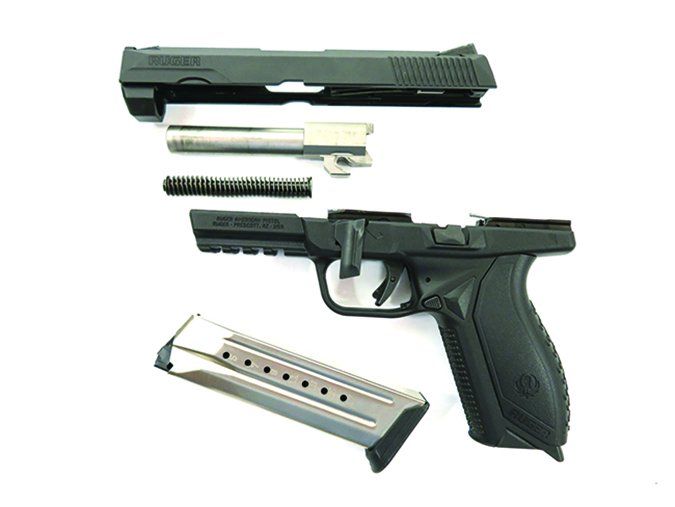
The American wore a matte-black finish that was well executed, and it felt good in hand with a bore axis low to the shooter’s hand. It uses a Browning-style locked-breech action with a new barrel cam, which according to Ruger, is designed to reduce felt recoil by controlling the rearward movement of the slide when round is fired. It also uses a solid-steel recoil rod with a trapped recoil spring. We felt recoil was quite manageable with all three pistols. The extra ounces the American weighed also helped dampen felt recoil.
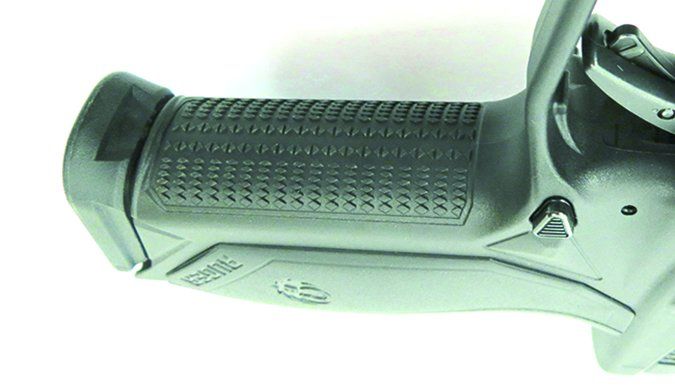
We like how the American operated. The slide is chiseled at the muzzle so it is easy to holster. Slide serrations at the rear of the slide are in an X-style pattern and offer lots of texture to rack the slide. Sights consisted of Novak’s LoMount three-dot system, which are excellent sights. The rear sight is windage adjustable, and the front is dovetailed into the slide. It has a large external extractor and a viewport in the top of the breechblock that allows for visual confirmation of a loaded or empty chamber.
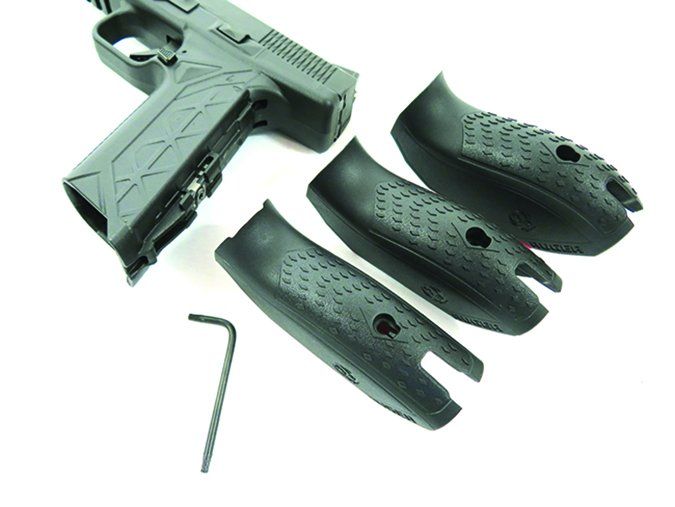
It uses what Ruger calls a pretensioned striker-ignition system. Some striker designs use the cycling of the slide to partially cock the striker, which is then fully cocked by depressing the trigger. When the slide is cycled, the striker is in the fully cocked position, so when the trigger is pressed, it instantly releases the sear. This is supposed to create a shorter, crisper trigger pull. The trigger is made of steel and so is the safety-lever insert. There is a trigger stop built into the inside of the trigger to stop overtravel, which is fine for a target pistol but could be liability for the Ruger. If debris gets caught between the inside of the trigger and the trigger stop, the pistol may not fire because the full press of the trigger cannot be completed.
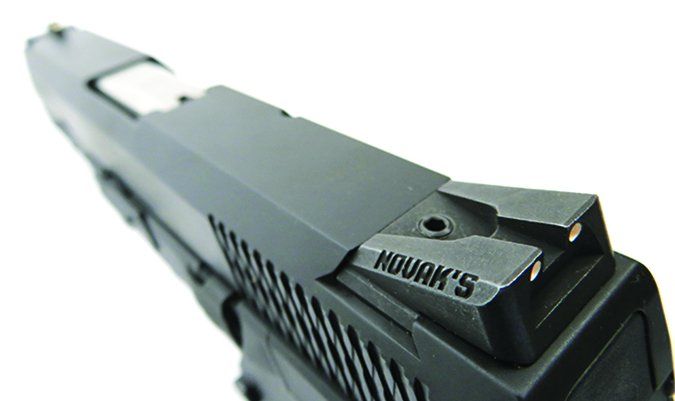
The slide stop and magazine release are ambidextrous, which we appreciated. Some testers felt the triangular magazine-release button was a bit small. The polymer receiver has an assortment of grip textures. The rear strap has a coarse diamond texture; the grip insert uses a fine pebble texture; and the front strap has a small diamond texture. We found swapping grips to be a bit of a task until we figured it out and felt the inserts were not as integrated to the receiver as the inserts on the S&W. A hole in the rear strap gives access to a Torx screw. The Torx tool is included with the pistol, but we liked the S&W set up better. No tool to lose. The insert on the American allowed for a range of hand sizes, which we liked. A rail is built in to accept lights or laser pointers.
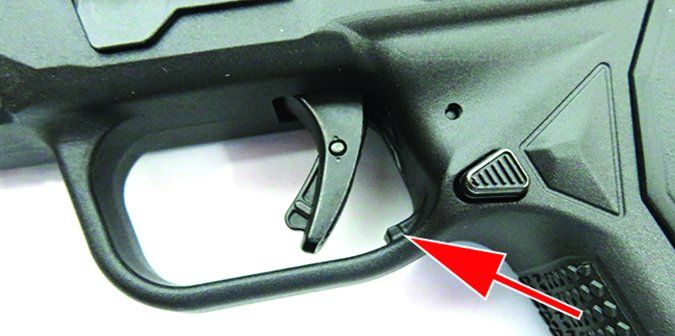
Field stripping was simple due to the takedown lever. Unload, rotate the lever, and you have five pieces. The magazines have witness holes on the side, and they were easy to load, even to the last round. Our thumbs thank you. The bodies of the magazines are coated with a nickel-teflon layer. The floorplate had a built-in lip that, when the magazine was inserted, formed the bottom edge of front strap.
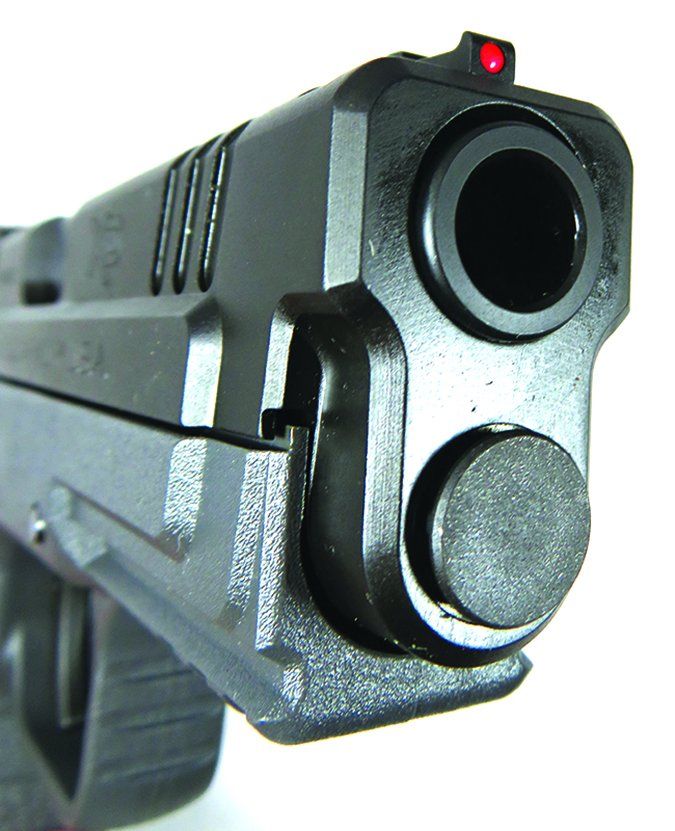
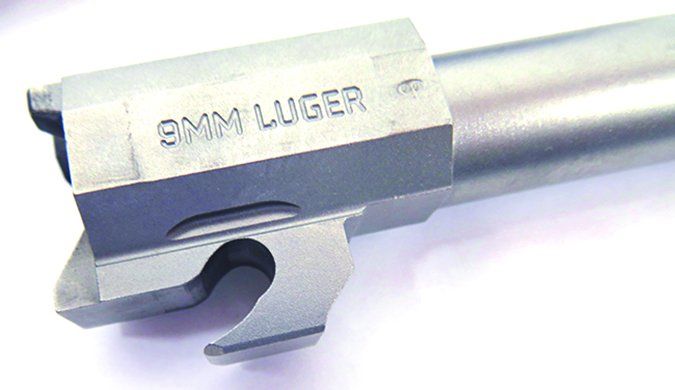
At the range, we found the American was not as accurate as the S&W, though we are talking about fractions of an inch, and this is a defense firearm, not a target pistol. Accuracy averaged a little over 2 inches across all ammo. With SIG 115-grain FMJ ammo, we were able to shoot a best five-shot group of 1.7 inches at 25 yards. The American is quite capable. In closer fast fire, we found the pistol to be easy to control, due in part to the bore axis being close to our hands. Even with an assortment of ammo bullet styles and weights, the pistol performed without a hitch. There was a fair amount of take-up with the trigger before it broke. The break was consistent, though not as crisp as the S&W and Springfield handguns.
Our Team Said: We found the American to be a capable pistol, but it was not as refined as the S&W. Accuracy was good and reliability was perfect. The grip inserts were a bit difficult to swap out until we learned the process.
Springfield Armory XD MOD.2 4-Inch Service Model 9mm Luger, $565
GUN TESTS GRADE: A-
The XD MOD.2 was a very easy to shoot pistol due to the fiber-optic front sight, the thin, textured grip, and very consistent trigger.
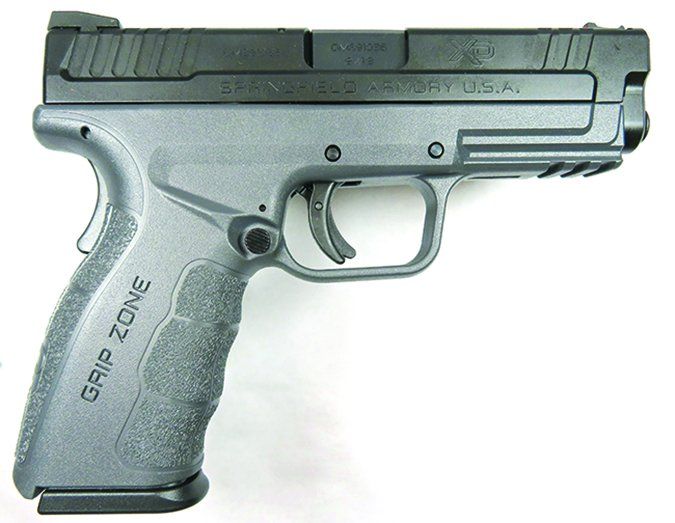
| ACTION TYPE | Striker fire, locked breech, tilting barrel |
| OVERALL LENGTH | 7.3 in. |
| OVERALL HEIGHT | 5.5 in. |
| MAX WIDTH | 1.3 in. |
| WEIGHT UNLOADED | 27.5 oz. |
| WEIGHT LOADED | 33.9 oz. |
| SLIDE MATERIAL | Steel |
| SLIDE-RETRACTION EFFORT | 18 lbs. |
| RECEIVER MATERIAL | Polymer |
| FINISH | Black slide/gray frame |
| FRONT STRAP HEIGHT | 2.3 in. |
| REAR STRAP HEIGHT | 3.1 in. |
| BARREL LENGTH | 4 in. |
| PISTOL GRIP | Textured polymer |
| GRIP THICKNESS (max) | 1.19 in. |
| GRIP CIRCUMFERENCE (max) | 5.75 in. |
| MAGAZINE | (2) 16-rd. stainless steel |
| REAR SIGHT | Steel, fixed, white two dot |
| FRONT SIGHT | Steel, fixed blade, fiber optic |
| SIGHT RADIUS | 6.25 in. |
| TRIGGER PULL WEIGHT | 6.1 lbs. |
| TRIGGER SPAN | 2.6 in. |
| SAFETY | None |
| WARRANTY | Limited lifetime |
| TELEPHONE | (800) 680-6866 |
| WEBSITE | Springfield-Armory.com |
| MADE IN | Croatia |
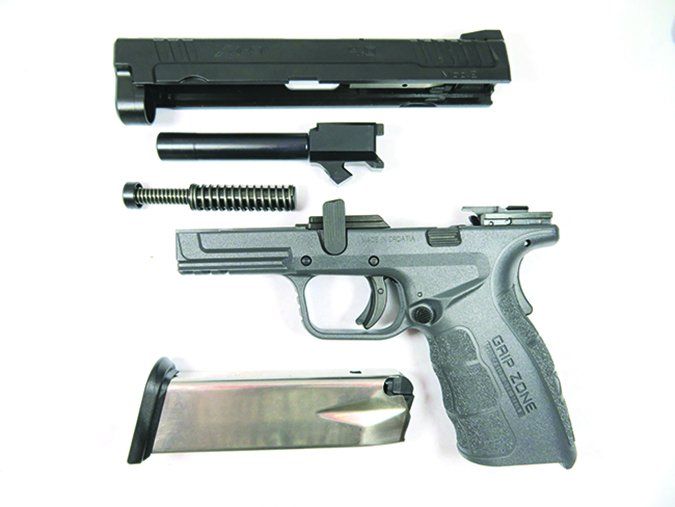
We tested the XD MOD.2 3.0-inch subcompact in February 2016 and gave it an A, so when we acquired an XD MOD.2 4-inch compact, our expectations were high and Springfield Armory delivered. The XD MOD.2 4-inch does not have modular grip, so we marked it down half a grade, but found we really liked the way the grip fit our hands. The multi-texture grip is what Springfield calls Grip Zone, and it actually allows the user to have a secure grip. The S&W had palm-swell inserts that provided more hand-to-grip contact than the Springfield and Ruger. Grip Zone is designed with three different types of textures. Zone 1 texture is located on the front and back straps, Zone 2 is aggressive and is located on the side panels, and Zone 3 texture is a pebble texture that covers the frame. The receiver is also molded so your finger falls naturally toward the trigger. The front strap has very shallow finger grooves. In hand, most testers agreed the XD MOD.2 4 felt good in hand, but we are getting ahead of ourselves.
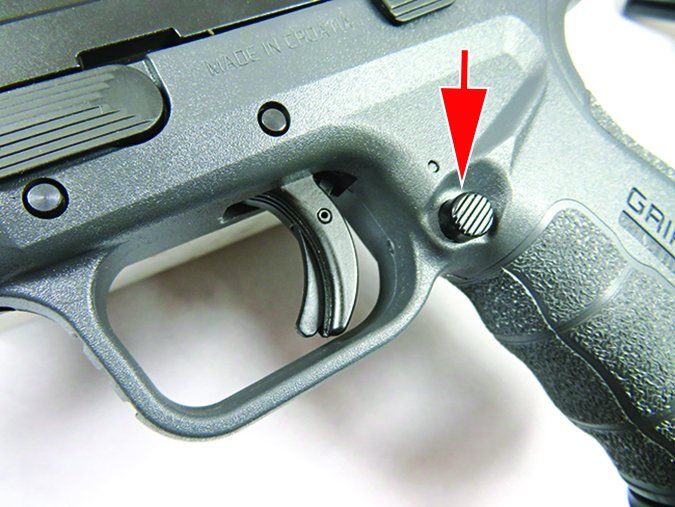
The XD MOD.2 comes in a hard case with two stainless-steel magazines. Our sample has a gray polymer receiver and a black slide. Fit and finish were excellent, as was our expectation. The slide is sculpted to reduce weight and provide positive cocking. Coarse serrations are located at the muzzle and rear of the slide, so whatever method you use to rack the slide, it can be performed with ease. The XD MOD.2 4 required the user to exert 18 pounds of effort to rack the slide and cock the weapon. The Ruger required 17 pounds, and the S&W required 19 pounds. The low-profile three-dot sights were the best of all three pistols.
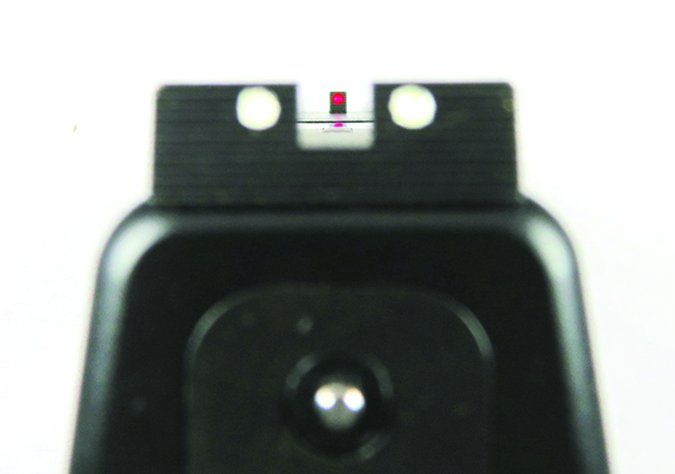
Though red fiber-optic front sights are not traditional, they do allow a user to better aim the pistol because the red front dot stands out better against a dark target. The front sight was dovetailed, as was the rear sight, which could be tapped left or right to adjust windage. The rear sight was also flush with the rear of the slide, providing a maximum sight radius. Plus, the rear sight was serrated to cut sun glare. Nice sights. Also on the slide’s top side is a loaded-chamber indicator that can be seen and felt. At the rear, a silver pin protrudes from the rear slide cover, indicating the pistol is cocked. We like this feature since it instantly tells the user the pistol is cocked and ready to be fired. The other pistols did not have this feature.
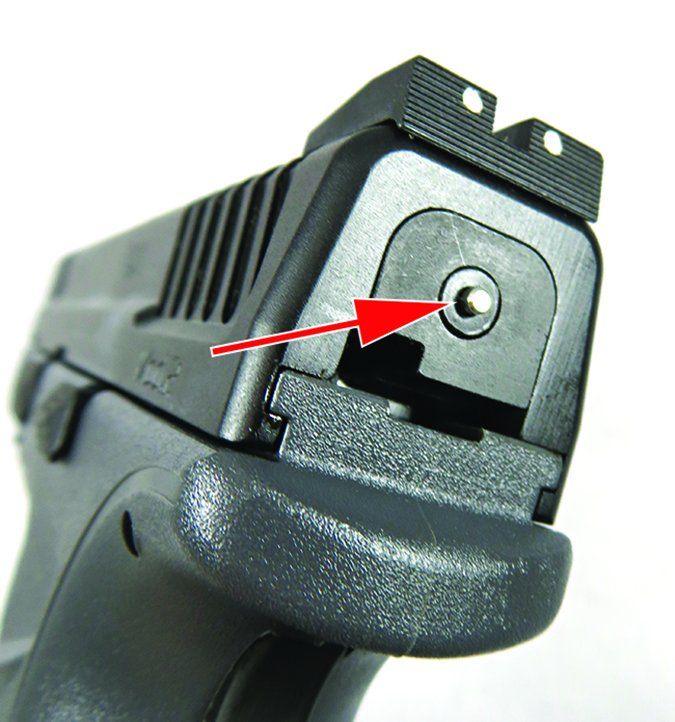
Controls consisted of an ambidextrous magazine-release button that we thought was a good size and protruded sufficiently, with a raised portion of the receiver protecting the button from accidental magazine dump. The slide stop/ takedown lever is located on the left side.
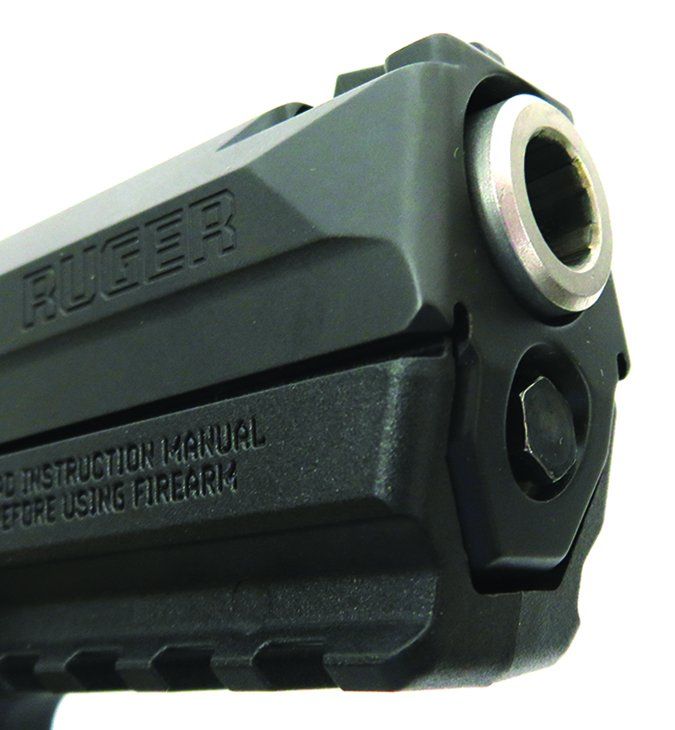
A grip safety adds another level of safety to striker fire, and we liked the grip safety even if it was redundant to the safety lever built into the trigger. The trigger was very consistent but had a lot of take up. We liked the S&W and SA triggers better. There was no trigger stop molded into the receiver, unlike the Ruger and S&W.
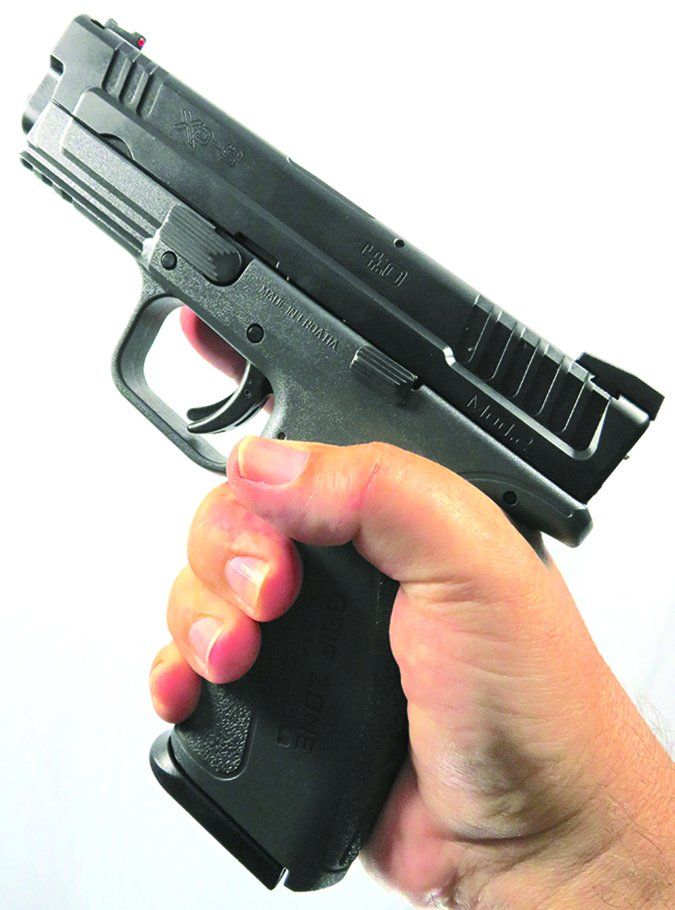
At 25 yards, we found the red fiber-optic front sight to be an asset, and along with the trigger, one tester was able to shoot a 1.3-inch five-shot group with Hornady American Gunner 115-grain XTP ammo. Average accuracy with all ammo was 2.0 inches. For speed shooting, we found the grip helped us control the XD MOD.2 4. All three pistols were pleasant to shoot, and we would rank the pistols even on this point.
Our Team Said: If not having a modular grip is not a deal breaker, then the XD MOD.2 is a gun worth considering. More compact than the Ruger and S&W, it could be used for everyday carry. The sights, trigger, grip, and accuracy sold us.
Special thanks to Eastern Outfitters of Hampstead, NC, for their assistance.
Written and photographed by Robert Sadowski using evaluations from Gun Tests team testers.


